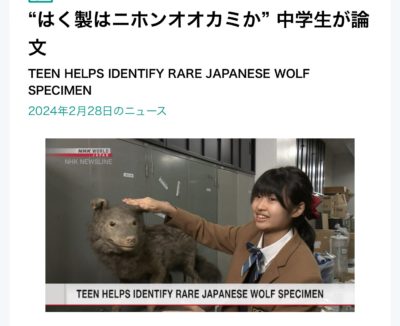ニュースで学ぶ現代英語 24/3/29(金)-関連記事-“はく製はニホンオオカミか” 中学生が論文
ブログ記事の抜粋
ニュースで学ぶ現代英語 24/3/29(金)-関連記事-“はく製はニホンオオカミか” 中学生が論文
10代の若者が、珍しいニホンオオカミの標本の認定に貢献
Teen helps identify rare Japanese wolf specimen
Teenager helps identify Japanese wolf skin specimen
Wednesday, Feb. 28, 10:19
ニホンオオカミの皮の標本の識別に協力するティーンエイジャー
2月28日水曜日、10:19
A study led by a 13-year-old Japanese girl indicates that what was believed to be the skin of a kind of dog, which was on display at a national museum, may actually be the hide of a Japanese wolf. The wolf species is now extinct.
国立博物館に展示されていたある種の犬の皮だと思われていたものが、実はニホンオオカミの皮だった可能性があることが、13歳の日本人少女が主導した研究で示された。 オオカミの種は現在絶滅しています。
Komori Hinako, a first-year junior high school student in Tokyo, and researchers from the National Museum of Nature and Science and another institution released a report about the discovery in February.
東京都の中学1年生、小森日向子さんと国立科学博物館などの研究者らは2月、この発見に関する報告書を発表した。
Komori was inspired to conduct the study four years ago when she saw the specimen on display as part of a special exhibition of the museum’s collections. She thought it must be that of a Japanese wolf that she had seen in books.
小森さんは4年前、博物館のコレクションの特別展の一環として展示されていた標本を見たときに、この研究を行うきっかけとなった。 彼女は、それは本で見たニホンオオカミに違いないと思いました。
The specimen was labeled as the skin of a kind of Yamainu, or wild dog. With the help of the experts, Komori examined the dimensions of the mounted skin and the history described in its record.
標本には、ある種の山犬、つまり野犬の皮とラベルが貼られていた。 小森さんは専門家の協力を得て、装着された皮膚の寸法と記録に記された歴史を調査した。
After two years of study, the team concluded that it believes the specimen is from a Japanese wolf that was kept at the Ueno Zoo in Tokyo more than 100 years ago.
2年間の研究を経て、研究チームはこの標本は100年以上前に東京の上野動物園で飼育されていたニホンオオカミのものであると考えられると結論づけた。
The researchers say Japanese wolves used to be widely seen in the country. But it is believed that the animals became extinct about 100 years ago. The researchers say there are only a few skin specimens of the animal in existence in Japan and overseas.
研究者らは、ニホンオオカミはかつて国内で広く見られたと述べている。 しかし、この動物は約100年前に絶滅したと考えられていま 研究者らによると、この動物の皮膚標本は国内外で数点しか現存していないという。
Komori said she is very happy that she was able to present her findings to many people. She said she believed that the specimen was from a Japanese wolf. She added that she wants to continue to study the animal.
小森さんは、自分の研究結果を多くの人に発表することができてとてもうれしいと語った。 彼女は、標本はニホンオオカミのものだと信じていると語った。 彼女は、この動物の研究を続けたいと付け加えた。
Kawada Shin-ichiro of the museum’s department of zoology, who supported Komori’s study, said he is glad that the specimen has been identified. Kawada stressed that it is important to keep specimens for the future.
小森さんの研究を支援した同博物館動物学部の川田真一郎さんは、標本が特定できてうれしいと語った。 川田氏は、将来のために標本を保存しておくことが重要だと強調した。

